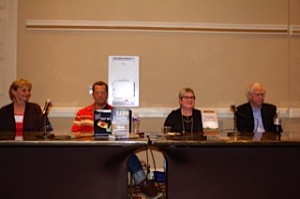I didn’t actually get to “attend” this virtual event in person, as the sessions were mostly while I was at work, but I’m rewatching the highlights on the website and enjoying them.

My favorite sessions so far have been “Take Off Your Pants” (a session urging you to outline at least the main points of your plot) and “Up The Ante” (about adding conflict to your story). Of course, the Jane Friedman session about self-publishing is also quite informative.
Some of the tips we’ve learned so far include the “beats” of your story:
- Opening Scene: we see the character in their ordinary life
- Inciting Event: this changes their entire life with no way back
- Character Realizes External Goal: they know what they want
- Display of Flaw: we see the character’s main flaw that has prevented them from gaining that goal before
- Drive for Goal: character makes an effort to reach their goal
- Antagonist Revealed
- Thwart #1: the antagonist (or something else) gets in the way of the goal
- Revisiting Flaw: we see the flaw keeping the character from the goal
- New Drive for Goal: the character tries even harder
- Antagonist Attacks
- Thwart #2: Another obstacle in the way
- Changed Goal: the character finds a new goal
- Ally Attacks: a friend/mentor points out flaws/challenges character
- Girding the Loins: the character finally recognizes their flaws
- Battle: the character fights the antagonist
- Death: the dark moment where everything looks hopeless
- Outcome: end of the story/wrap-up
And for Conflict. we learned the following:
- Central Conflict: the main engine driving the story; the central question of the book; the major challenge the protagonist must overcome by the end of the story
- Underlying (Chronic) Conflict: an outside conflict thrust onto the character
- Internal Conflict: thoughts/emotions
- Transient Conflict: circumstantial (Act of God)
A scene must either advance the plot or reveal something about the character. You need some sort of conflict in each scene, also, either explicit or internal. Ask yourself, “What’s the worst that could happen here?” — and then make it happen.
This was a panel at the Tony Hillerman Conference, featuring Anne Hillerman, CB McKenzie, Sara Hoklotubbe, and John Sandford.
Q: Do you outline or wing it?
John: There’s no right way to do it. I actually do both. I do not outline for the first 75-80 thousand words. As I’m struggling through the story, a lot of weird stuff comes up, and can add a funky quality to the work. Then, when I need the velocity to pick up, I outline to the end. Outlining makes your prose tighter and faster.
Sara: I wrote a synopsis, started on an outline, kept changing it so much that I finally threw it away. I do have a large whiteboard that I keep everything on: each character, how old they are, etc.
CB: It depends on what you’re doing. Different works require different approaches. I outline for a plot-driven novel, but if a character goes off in a new direction, I’ll follow the character.
Anne: My whole writing background has been nonfiction. You don’t really outline, but you know what you have to include in each section. I got a few scenes down, and realized that I needed some structure. I’ve tried to be more organized with my second book.
Q: How do you keep from getting lost if you’re not outlining?
Anne: Thank goodness for “find and replace!” I can go back and take out all those lovely descriptions and whatever wasn’t part of the story.
CB: If you’re writing a certain type of story, the story itself will keep you on track. Make your story compelling enough. If you’re failing to do that, you’re failing at the novel.
Sara: When I write, it’s like watching a movie in my head. I’ve been called a perfectionist. I revise as I go along.
John: I work much the same. I’ve been doing this long enough to have an instinct for what’s good. The most important chapters are the first and the last. Remember that you don’t have to write the entire story at once: you can go back and fix stuff.
Anne: One reason it took me three years to write Spider Woman’s Daughter was that I’m also a perfectionist. I finally realized I was just treading water, and I’d have to move forward and revise later.
CB: That’s where an outline can help you; they give you a practical way to move on.
Thanks for the great advice, guys!


